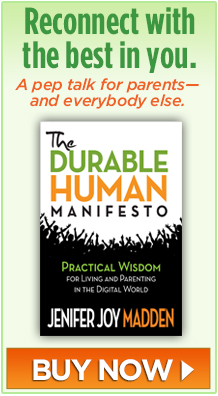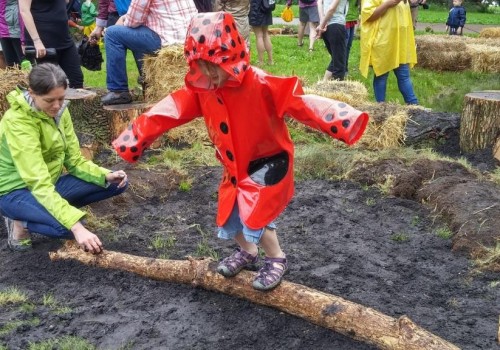
Could a soggy patch of dirt and some logs be better for kids to play on than sleek slides and swingsets? Absolutely, say some child development experts.
Angela Hanscom, for instance, is an occupational therapist who sees strange new symptoms among today’s kids. In her research and testing, Hanscom observes that more and more elementary-age children:
- Fidget and have trouble paying attention in class.
- Tend toward clumsiness, sometimes falling out of their seats and running into other people in hallways.
- Fail tests of core muscle strength and balance.
- Don’t know their own strength, so accidentally hurt other kids when playing games like tag.
- Are easily frustrated and “cry at the drop of a hat.”
In her book Balanced and Barefoot: How Unrestricted Outdoor Play Makes for Strong, Confident, and Capable Children, Hanscom blames kids’ emerging emotional and physical deficits on too much time with technology and not enough time outside. “When playing video games, kids don’t fully use their muscle force.”
Meanwhile, at many U.S. schools, academic pressures have greatly curtailed recess. But even when students do have time outside, swings, climbing bars, and other typical playground equipment only involves certain aspects of their bodies. “For years we’ve been doing upper body, gross motor as the pure focus of playgrounds and it’s not really working for us,” according to Adam Bienenstock, a Canadian nature playground designer. “We need kids to have their brains fully tuned in and turned on and that doesn’t happen unless their senses are engaged. So, smooth, perfect anything doesn’t work. ”
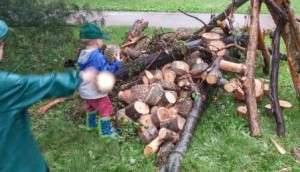 Sticks, cross-sections of slender trees (known as wood cookies), straw bales, and other natural objects kids can pick up, pile, and form into their own creations are standard in nature playgrounds. Built at ground-level, they are by definition safer than typical playgrounds because serious injuries tend to occur mainly in falls from the height of at least six feet.
Sticks, cross-sections of slender trees (known as wood cookies), straw bales, and other natural objects kids can pick up, pile, and form into their own creations are standard in nature playgrounds. Built at ground-level, they are by definition safer than typical playgrounds because serious injuries tend to occur mainly in falls from the height of at least six feet.
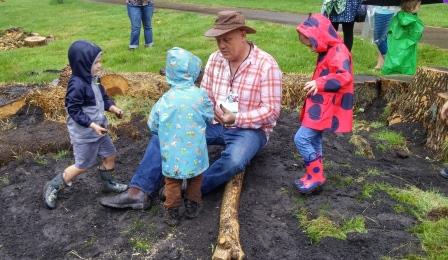
A pop-up nature playground was constructed in a grassy area of St. Paul, MN park as part of the Children and Nature Network conference.
Free-form playgrounds are beloved by kids because they have: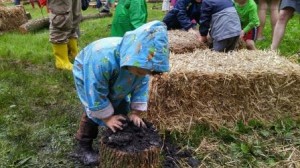
- fewer rules
- less adult oversight
- more independence
- a tingly sense of risk
- ways to get dirty
In her sensory-enhancement camps, Hanscom incorporates hours of daily outdoor unstructured play. Her goal is for kids to use their bodies’ vestibular systems, which determine balance and feed into their limbic systems, which regulate emotions.
She wants kids to move as much and in as many ways as possible. “When you restrict movement, things get stuck. There are problems with balance and coordination. If you aren’t moving enough, your vestibular system will atrophy too and you are more prone to falls.”
Kids with plenty of outdoor play learn life-lessons that can’t get in a classroom. 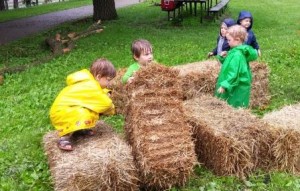 As I write in How To Be a Durable Human: Revive and Thrive in the Digital World Through the Power of Self-Design, when they direct their own play kids cooperate more and tend to invent their own games. This bodes well for them as adults because—in the words of Last Child in the Woods author Richard Louv—“it has something to do with developing entrepreneurs in the future.”
As I write in How To Be a Durable Human: Revive and Thrive in the Digital World Through the Power of Self-Design, when they direct their own play kids cooperate more and tend to invent their own games. This bodes well for them as adults because—in the words of Last Child in the Woods author Richard Louv—“it has something to do with developing entrepreneurs in the future.”
For older kids, being outdoors affords a unique form of sanctuary. As I write in my book,
Outside in the sun and wind, the information kids have consumed inside has a chance to percolate.
Louv has hundreds of clever, easy suggestions for how adults and kids can enjoy the outside in his new Vitamin N: The Essential Guide to a Nature-Rich Life. For inspiration, also see Tao of Sustainability: Cultivate Yourself to Heal the Earth by Gregory Ripley.
But besides all the sober reasons for more messy outdoor play, there’s another that Adam Bienenstock enthusiastically points out: “Aside from anything else, the honest truth? It’s more fun. It’s just more fun!”
Here’s my 2-minute interview with Adam Bienenstock on location at the Children and Nature Network pop-up playground:
Another amazing nature playground is close to Washington, D.C.
To learn more about how to embrace your own nature as you live in harmony with your technology, I invite you to check out the tips and tricks in How To Be a Durable Human: Revive and Thrive in the Digital Age Through the Power of Self-Design.
In the meantime, download this free checklist for how to plan your family’s time wisely!
For more Durable Human posts, news, and freebies, sign up here .
Info about this author on Google+.


